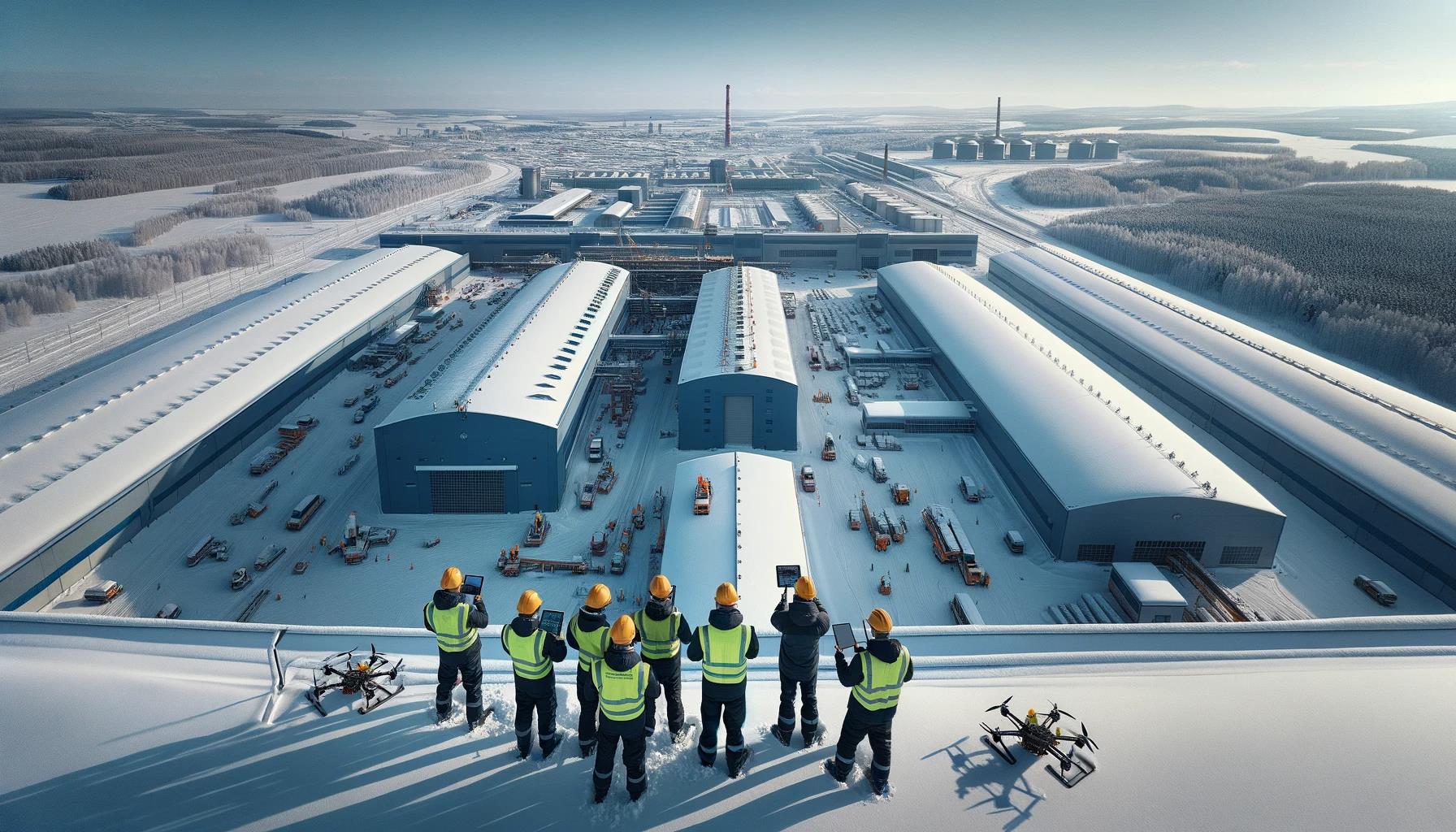Production halls with large roof spans, such as large warehouses, factories, shopping malls or airport terminals in regions prone to heavy snowfall, can be particularly susceptible to damage or even collapse under the weight of accumulated snow in the winter months.
Due to the variety of potential overload situations, including extreme amounts of snow and rain at low temperatures, there is a risk that the roofs of production halls may be overloaded beyond the expected maximum load. This increases the need to take into account potential extreme weather conditions in the design of these facilities to ensure their safety and durability throughout their lifetime.
Structural failure of production hall roofs under the influence of snow load can result from many factors, including: actual snow load exceeding the designed standards, conditions related to snow backfilling and slipping, improper workmanship, lack of proper maintenance, design errors, inadequate drainage system, as well as outdated construction in older facilities. Often, the problem is that snow load standards were not properly taken into account in building regulations that were valid at the time of building design.
In situations of extreme or unforeseen weather events that cause overloading, poor workmanship or design errors can make structural building components in affected regions unable to withstand the extreme loads caused by heavy snowfall or other complex weather conditions.
In areas where extremely high snow loads are expected, such as in mountainous areas, the construction of buildings is adapted to high snow loads. In regions where snowfall is rare, snow loads on roofs are less significant. This increases the risk that abnormal weather conditions can lead to damage or even collapse of roofs.
Winter storms, bringing rain, snow, and ice, can cause several roof collapses every year. This type of damage can cost millions of dollars and disrupt the normal operations of businesses. Therefore, it is essential to monitor these roofs regularly to prevent significant financial and material losses.
In addition, unnoticed damage caused during a single weather event can impair the ability of the structure to withstand future, even smaller events, which would normally be unharmed. Not only large snowstorms can harm roofs. Even without a single, large snowstorm, frequent snowfalls that do not have time to melt can accumulate, exceeding the permissible roof load. Rain, following snowfall, can further saturate the snow, significantly increasing its mass.
A structural monitoring system can provide building owners and authorities with peace of mind about the potential risks of overloading and the risk of structural damage and possible injury to people. This system is effective in measuring static and dynamic loads on a building structure, allowing you to assess how critical structural components respond to different load conditions.
Wireless sensors can monitor stresses and corresponding loads on flat roofs or roofs with slopes, installed at strategic measurement points. These sensors allow you to monitor loads on different types of roofs, measuring the load on the main structural components of the roof, which allows you to assess the total load of the building and provides real-time information on the stress state of the roof, even in severe weather conditions such as ice or moisture.
The roof load can be calculated by analyzing the deflection of the main structural components, such as girders. Using structural parameters and geometric features such as Young’s modulus and inertia factors of the roof material, as well as the shape and dimensions of spans, girders, and trusses, it is possible to accurately determine the roof load.
Wireless sensors are ideal for monitoring building roofs and structures due to their continuous, precise data collection, high-speed data transmission, and resistance to harsh weather conditions. They are cordless and energy-efficient, making them easy and cost-effective to install and maintain. These sensors offer an adjustable trigger threshold and sampling intervals, providing accurate and reliable results without the need for on-site calibration.
In addition, the technology used in the sensors can detect high-load events that can occur in the event of changing snow conditions as it moves, drifts or slides on the roof. This technology collects data at a rate of 50-100 samples per second, allowing for detailed analysis of high-stress events and their comparison with general stress data.
The ability to measure high loads is important for roof monitoring, as overwhelming changes in deformation can create the need for high-rate data collection and transmission. Wireless sensors are well suited for this application, as the trigger threshold can be adjusted from 16μStrain to 512μStrain, and the sampling interval can be changed from 25 to 200 ms.

The data from the detectors helps engineers make informed decisions about the load conditions of the roof of the structure to enable them to perform possible evacuation activities, roof support and loads/snow removal or the need for further inspection or repair of the roof in an appropriate response time. In addition, these products can provide early warning of imminent breakdown/roof collapse and disaster with the Alarm function, alerting you when pre-set data thresholds are exceeded (by sending a warning email /text/notification to the relevant authority). A real-time monitoring system can therefore provide initial warnings of the potential effects of snow loads before possible damage or collapse of the roof. In addition, using the relevant location data, authorities can easily find the location of the overload and assess its status with the help of strain/stress/load and temperature data. Because the effects of temperature on roof structural elements can also be important and relevant for data collection and interpretation; The sensors have built-in ambient temperature sensors, so this information can be incorporated into all data collection systems.
The roof monitoring system, thanks to its energy-efficient sensors, is ideal for both short- and long-term use. A key benefit of this energy efficiency is that the sensors can be reused in different applications without the need to change batteries or recharge during testing. Users can move these devices from one place to another or use them for experimental testing. Once the tests are complete, the same sensors can remain on structures for long-term and continuous monitoring of roofs, requiring no battery replacement or other maintenance throughout their lifetime.
The wireless design of the system is quick and easy to install, as it does not require additional wiring. This reduces installation costs and the time it takes to get the system up and running, making these solutions a cost-effective choice for building owners who need high-quality data for roof monitoring and decision-making.
Autor: Tomasz Matuszek; Dział Marketingu - Firma Gulajski

